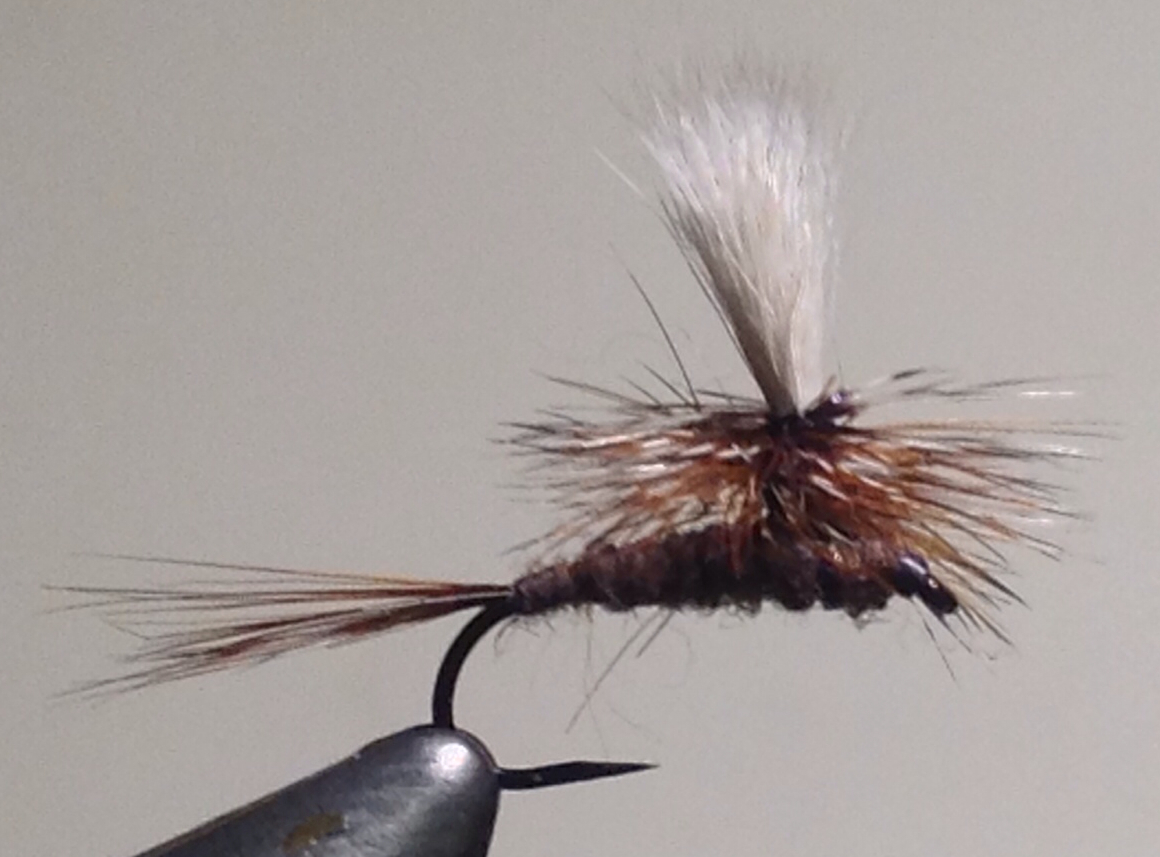Adams (dry fly) on:
[Wikipedia]
[Google]
[Amazon]
The Adams is a traditional
 The Adams has been tied with a variety of materials and variations. The most common variation is the Parachute Adams where the hackle is tied parachute style around a wing base of white calf hair. The variation gives the fly greater buoyancy and visibility in rough water. Other variations include spentwings, downwings, females tied with a yellow body tag resembling an egg sac, hairwings, and with different tailing material such as elk, deer or moose.
The Adams has been tied with a variety of materials and variations. The most common variation is the Parachute Adams where the hackle is tied parachute style around a wing base of white calf hair. The variation gives the fly greater buoyancy and visibility in rough water. Other variations include spentwings, downwings, females tied with a yellow body tag resembling an egg sac, hairwings, and with different tailing material such as elk, deer or moose.
dry fly Dry fly fishing is an angling technique in which the lure is an artificial fly which floats on the surface of the water and does not sink below it. Developed originally for trout fly fishing.
The fish and the dry fly
Fly fishing for trout can be ...
primarily used for trout
Trout are species of freshwater fish belonging to the genera '' Oncorhynchus'', '' Salmo'' and '' Salvelinus'', all of the subfamily Salmoninae of the family Salmonidae. The word ''trout'' is also used as part of the name of some non-salm ...
. It is considered a general imitation of an adult mayfly, flying caddis or midge. It was designed by Leonard Halladay from Mayfield, Michigan
Mayfield is an unincorporated community in Grand Traverse County in the U.S. state of Michigan. It is located in Paradise Township between Kingsley and Traverse City along South Garfield Road (County Road 611). As an unincorporated community, ...
in 1922, at the request of his friend Charles Adams. The Adams has been considered one of the most popular, versatile, effective and best selling dry flies since its creation.
Origin
In 1922, Leonard Halladay, a Michigan fly tyer conceived the Adams as a general mayfly imitation. It was first fished by an Ohio attorney and friend of Halladay, Charles F. Adams on theBoardman River
The Boardman River ( '), also known as the Ottaway River ( ') or the Boardman–Ottaway River, is a U.S. Geological Survey. National Hydrography Dataset high-resolution flowline dataThe National Map, accessed November 21, 2011 river in the northw ...
near Traverse City, Michigan
Traverse City ( ) is a city in the U.S. state of Michigan. It is the county seat of Grand Traverse County, although a small portion extends into Leelanau County. It is the largest city in the 21-county Northern Michigan region. The population wa ...
. Charles Adams reported his success with the fly to Halladay, who named the fly after his friend. The small community of Mayfield, Michigan, bids itself as the "Birthplace of the Adams Fly".
Materials
* Hook-dry fly Dry fly fishing is an angling technique in which the lure is an artificial fly which floats on the surface of the water and does not sink below it. Developed originally for trout fly fishing.
The fish and the dry fly
Fly fishing for trout can be ...
hook (size 10-22)
* Thread-flat waxed nylon thread
* Hackle-dry fly hackles
* Tail-hackle fibers grizzly
* Abdomen-super fine dubbing
Dubbing (re-recording and mixing) is a post-production process used in filmmaking and video production, often in concert with sound design, in which additional or supplementary recordings are lip-synced and "mixed" with original production sou ...
* Wing-grizzly hackle tips
Variations
 The Adams has been tied with a variety of materials and variations. The most common variation is the Parachute Adams where the hackle is tied parachute style around a wing base of white calf hair. The variation gives the fly greater buoyancy and visibility in rough water. Other variations include spentwings, downwings, females tied with a yellow body tag resembling an egg sac, hairwings, and with different tailing material such as elk, deer or moose.
The Adams has been tied with a variety of materials and variations. The most common variation is the Parachute Adams where the hackle is tied parachute style around a wing base of white calf hair. The variation gives the fly greater buoyancy and visibility in rough water. Other variations include spentwings, downwings, females tied with a yellow body tag resembling an egg sac, hairwings, and with different tailing material such as elk, deer or moose.
Notes
Further reading
* ''The Orvis Fly-fishing Guide'' by Tom Rosenbauer ; photographs by Tom Rosenbauer & the Orvis Company ; illustrations by Bob White. Guilford, Conn. : Lyons Press, (c2007) * ″The Legend of Halladay and His Adams″ by John Falk; ′The American Fly Fisher′, Vol 42 No 4. Manchester, Vermont : American Museum of Fly Fishing, (c2016), {{Fly fishing Dry fly patterns